![]()
![]()
![]()
Use LEFT and RIGHT arrow keys to navigate between flashcards;
Use UP and DOWN arrow keys to flip the card;
H to show hint;
A reads text to speech;
52 Cards in this Set
- Front
- Back
|
Force is:
|
a push or pull exerted by one material object or substance on another
|
|
|
External Forces are:
|
pushes or pulls on the body that arise from sources outside the body
Ex. Gravity |
|
|
Internal Forces are:
|
forces that act on the body but arise from sources within the body
Ex. Muscles , ligaments, and bones |
|
|
Vector Forces are:
|
A point of application on the object being acted on
|
|
|
Magnitude is:
|
quality of the force being exerted
|
|
|
Force Vectors have:
|
a point of application or “base”
an action line w/ a direction – direction and orientation. a magnitude – amount of force being exerted |
|
|
Force of Gravity is
|
always vertically downward toward the center of the earth regardless of the orientation in space of the object
|
|
|
Segmental Centers of Gravity is that:
|
Each segment in a body is acted upon by the force of gravity and has its own COG/COM
COG-center of gravity COM-center of mass |
|
|
COG of Human body is located where?
|
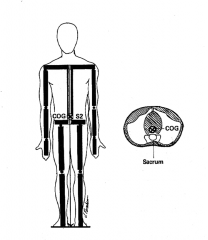
Slightly anterior to the second sacral vertebrae
|
|
|
COG of human body with movements can make the COG do what?
|

Fall outside the body
|
|
|
The _________ the COG is to the BOS, the ________ stable the object is.
farther/closer; more/less |
The closer the COG is to the BOS, the more stable the object is.
|
|
|
Newtow's 3rd Law "The Law of Reaction" is:
|
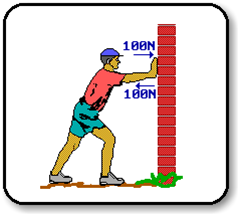
For every action there is an equal and opposite reaction
|
|
|
Reaction forces are:
|
always in the same line and applied to the different but contacting objects.
Directions=always opposite to each other Ex. Two touching objects either pull on each other or push on each other. |
|
|
Law of inertia is:
|
An object will remain at rest unless acted upon by an unbalanced force
Object: resist both the initiation of motion and a change in motion |
|
|
Velocity is a:
|
vector quantity with both magnitude (speed) and direction
|
|
|
Newton's Second Law "Law of Acceleration" is the:
|
Acceleration of an object is proportional to the unbalanced forces action on it and inversely proportional to the mass of that object.
|
|
|
Law of Acceleration occurs when:
|
1. change speed of an object
2. change in direction of movement **Greater the mass of an object, the greater the magnitude of net force needed either to get the object moving or to change its motion |
|
|
What are the classes of levers?
|
1. 1st class
2. 2nd class 3. 3rd class |
|
|
Effort Force is:
|
is producing the resultant torque (force acting in the direction of the rotation.
**Always the WINNER (in producing rotation around segment) |
|
|
Resistance Force is:
|
creating an “opposing” torque.
**Always the LOSER in producing rotation of a segment |
|
|
Effort Arm (EA):
|
the MA for the effort force.
**MA=moment arm |
|
|
Resistance Arm (RA):
|
the MA for the resistance force
**MA=moment arm |
|
|
The First Class lever is:
|

when two forces are applied on either side of an axis at some distance from that axis, creating rotation in opposite directions.
Ex. Seesaw |
|
|
In 1st Class lever what is the Effort Force, Resistance Force, Effort Arm, and Resistance Arm:
|
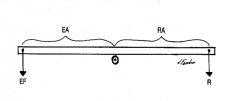
ER: force causing the motion
RF: force that is opposing the movement EA: lever arm of the effort force RA: lever arm of the resistance force |
|
|
Effort Arm can be larger, small, or equal to the resistance arm. T/F?
|
True
|
|
|
First Class Levers rarely occurs in humans but when it does is occurs where:
|
1. force of the triceps muscle on the olecranon of the ulna and an external force on the ulna are separated by the axis
2. Supraspinatus on greater tubercle of humerus is on opposite side of composite axis of rotation from GH joint |
|
|
Second Class Lever is:
|
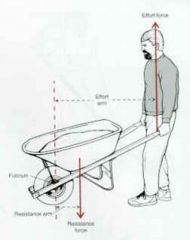
When two resultant forces are applied so that the resistance lies between the effort force and the axis of rotation.
|
|
|
In 2nd Class lever, the effort arm is always _______ than resistance arm.
Larger/Smaller/equal |

Larger
|
|
|
Third Class Lever is:
|
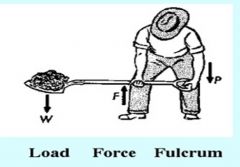
When forces are applied so that the effort force lies closer to the axis than does the resistance
|
|
|
In a 3rd class lever, effort arm will always be ________ than Resistance Arm.
Larger/Smaller/Equal |
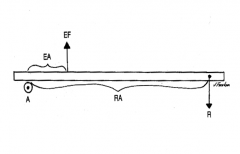
Smaller
|
|
|
A muscle creating joint rotation of its distal segment in the direction of its pull is most often part of which class of levers?
|
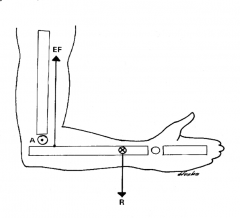
Third Class Levers
|
|
|
Biceps brachii performing flexion of the forearm and hand against the resistance of gravity is which class of levers?
|
Third Class Levers
|
|
|
When a muscle is contracting "concentrically", the muscle must be moving the segment to which it is attached in the direction of its pull.
Therefore the muscle will be the effort force (EF). |
True
**Muscle length is shortening "concentrically"!! So WINNING!! (3rd Class Levers) |
|
|
When a muscle is contracting eccentrically (actively lengthening), the muscle must be acting in a direction opposite to the motion of the segment; that is, the muscle must be the resistance force (RF).
|
True
(2nd Class Levers) |
|
|
When a muscle is contracting eccentrically, it generally serves to control (slow down) the acceleration of the segment produced by the effort force. T/F?
|
True
(2nd Class Levers) |
|
|
When a lever is in rotational equilibrium, the muscle acting on the lever is contracting isometrically. In such a case, labeling the muscle as the effort or resistance force is arbitrary
|
True
(1st Class Levers) |
|
|
Mechanical Advantage is:
|
*A measure of the efficiency of the lever
*Related to the class of lever *Used to develop an understanding of the relevance of the concept of classes of levers |
|
|
When the effort arm (EA) is larger than the resistance arm (RA), the mechanical advantage will be ________ than one.
Greater/Lesser/Equal to? |
Greater
|
|
|
The magnitude of the effort force can be ______ than the magnitude of the resistance.
Larger/Smaller? |
Smaller
|
|
|
When the EA is larger than RA, the mechanical advantage will be greater than one, & magnitude of the EF can be smaller than the magnitude of the resistance means?
|
That a small effort force can create more torque and overcome a larger resistance
|
|
|
In every second class lever, EA will always be ________ than RA since the resistance is _________ to the axis than the effort force.
Larger/Smaller; Closer/Farther |
Larger;Closer
|
|
|
The second class lever is ________efficient, M Ad greater than one, although the magnitude of the ratio of EA to RA will vary.
Always/Never |
Always
|
|
|
Third Class Levers, EA is always ________ than RA since the effort force lies _________ to the axis than the resistance.
Larger/Smaller; Closer/Farther |
Smaller;Closer
|
|
|
M Ad of the third class lever will always be _______ than one.
Less/Greater |
Less
|
|
|
Inefficient in that the magnitude of the effort required to move the lever will have to be greater than the magnitude of the resistance
|
??? ASK DANIEL
|
|
|
Work is:
|
done by a force applied to an object whenever the force is applied in the direction of motion of the object.
W = F x D |
|
|
Moment Arm is:
|
The shortest distance btw the action line & joint axis
**Found by measuring the length of a line drawn perpendicular to the force vector, intersecting the joint axis |
|
|
Moment Arm of a Muscle Force is:
|

When a force is applied to its lever at an angle greater than 90°
**MA is found by extending the vector |
|
|
The MA of any force is greatest when the action line is applied at 90° to its lever. T/F?
|
True
|
|
|
MA of the force of gravity is always greatest when the force is applied at 90° to the lever. T/F?
|
True
|
|
|
Force of gravity is applied to the forearms COG.
|

|
|
|
Linear Force Signs are
1. Forces applied up and right are _______. 2. Forces applied down and left are ______. Positive/Negative/Neutral |
1. Positive
2. Negative |

